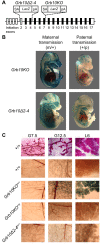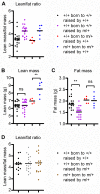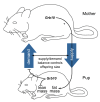Developmental programming mediated by complementary roles of imprinted Grb10 in mother and pup
- PMID: 24586114
- PMCID: PMC3934836
- DOI: 10.1371/journal.pbio.1001799
Developmental programming mediated by complementary roles of imprinted Grb10 in mother and pup
Abstract
Developmental programming links growth in early life with health status in adulthood. Although environmental factors such as maternal diet can influence the growth and adult health status of offspring, the genetic influences on this process are poorly understood. Using the mouse as a model, we identify the imprinted gene Grb10 as a mediator of nutrient supply and demand in the postnatal period. The combined actions of Grb10 expressed in the mother, controlling supply, and Grb10 expressed in the offspring, controlling demand, jointly regulate offspring growth. Furthermore, Grb10 determines the proportions of lean and fat tissue during development, thereby influencing energy homeostasis in the adult. Most strikingly, we show that the development of normal lean/fat proportions depends on the combined effects of Grb10 expressed in the mother, which has the greater effect on offspring adiposity, and Grb10 expressed in the offspring, which influences lean mass. These distinct functions of Grb10 in mother and pup act complementarily, which is consistent with a coadaptation model of imprinting evolution, a model predicted but for which there is limited experimental evidence. In addition, our findings identify Grb10 as a key genetic component of developmental programming, and highlight the need for a better understanding of mother-offspring interactions at the genetic level in predicting adult disease risk.
Conflict of interest statement
The authors have declared that no competing interests exist.
Figures





Comment in
-
Genomic imprinting of Grb10: coadaptation or conflict?PLoS Biol. 2014 Feb 25;12(2):e1001800. doi: 10.1371/journal.pbio.1001800. eCollection 2014 Feb. PLoS Biol. 2014. PMID: 24586115 Free PMC article.
-
Mother and offspring in conflict: why not?PLoS Biol. 2015 Mar 18;13(3):e1002084. doi: 10.1371/journal.pbio.1002084. eCollection 2015 Mar. PLoS Biol. 2015. PMID: 25785938 Free PMC article.
-
Coadaptation between mother and offspring: why not?PLoS Biol. 2015 Mar 18;13(3):e1002085. doi: 10.1371/journal.pbio.1002085. eCollection 2015 Mar. PLoS Biol. 2015. PMID: 25786111 Free PMC article.
Similar articles
-
Tissue-specific regulation and function of Grb10 during growth and neuronal commitment.Proc Natl Acad Sci U S A. 2015 Jun 2;112(22):6841-7. doi: 10.1073/pnas.1411254111. Epub 2014 Nov 3. Proc Natl Acad Sci U S A. 2015. PMID: 25368187 Free PMC article. Review.
-
Distinct physiological and behavioural functions for parental alleles of imprinted Grb10.Nature. 2011 Jan 27;469(7331):534-8. doi: 10.1038/nature09651. Nature. 2011. PMID: 21270893 Free PMC article.
-
Genomic imprinting of Grb10: coadaptation or conflict?PLoS Biol. 2014 Feb 25;12(2):e1001800. doi: 10.1371/journal.pbio.1001800. eCollection 2014 Feb. PLoS Biol. 2014. PMID: 24586115 Free PMC article.
-
Antagonistic roles in fetal development and adult physiology for the oppositely imprinted Grb10 and Dlk1 genes.BMC Biol. 2014 Dec 31;12:771. doi: 10.1186/s12915-014-0099-8. BMC Biol. 2014. PMID: 25551289 Free PMC article.
-
Brain-expressed imprinted genes and adult behaviour: the example of Nesp and Grb10.Mamm Genome. 2014 Feb;25(1-2):87-93. doi: 10.1007/s00335-013-9472-0. Epub 2013 Aug 24. Mamm Genome. 2014. PMID: 23974804 Review.
Cited by
-
Tissue-specific regulation and function of Grb10 during growth and neuronal commitment.Proc Natl Acad Sci U S A. 2015 Jun 2;112(22):6841-7. doi: 10.1073/pnas.1411254111. Epub 2014 Nov 3. Proc Natl Acad Sci U S A. 2015. PMID: 25368187 Free PMC article. Review.
-
Imprinted Zac1 in neural stem cells.World J Stem Cells. 2015 Mar 26;7(2):300-14. doi: 10.4252/wjsc.v7.i2.300. World J Stem Cells. 2015. PMID: 25815116 Free PMC article. Review.
-
Placental genotype affects early postpartum maternal behaviour.R Soc Open Sci. 2019 Sep 18;6(9):190732. doi: 10.1098/rsos.190732. eCollection 2019 Sep. R Soc Open Sci. 2019. PMID: 31598302 Free PMC article.
-
New Perspectives on Genomic Imprinting, an Essential and Multifaceted Mode of Epigenetic Control in the Developing and Adult Brain.Annu Rev Neurosci. 2016 Jul 8;39:347-84. doi: 10.1146/annurev-neuro-061010-113708. Epub 2016 Apr 25. Annu Rev Neurosci. 2016. PMID: 27145912 Free PMC article. Review.
-
Genomic imprinting and its effects on postnatal growth and adult metabolism.Cell Mol Life Sci. 2019 Oct;76(20):4009-4021. doi: 10.1007/s00018-019-03197-z. Epub 2019 Jul 3. Cell Mol Life Sci. 2019. PMID: 31270580 Free PMC article. Review.
References
-
- McMillen IC, Robinson JS (2005) Developmental origins of the metabolic syndrome: prediction, plasticity, and programming. Physiol Rev 85: 571–633. - PubMed
-
- Martin-Gronert MS, Ozanne SE (2012) Mechanisms underlying the developmental origins of disease. Rev Endocr Metab Disord 13: 85–92. - PubMed
-
- Ferguson-Smith AC (2011) Genomic imprinting: the emergence of an epigenetic paradigm. Nat Rev Genet 12: 565–575. - PubMed
Publication types
MeSH terms
Substances
Grants and funding
- 15938/CRUK_/Cancer Research UK/United Kingdom
- 085448/Z/08/Z/WT_/Wellcome Trust/United Kingdom
- G0300415/MRC_/Medical Research Council/United Kingdom
- 098012/WT_/Wellcome Trust/United Kingdom
- MR/J003417/1/MRC_/Medical Research Council/United Kingdom
- BB/C516936/1/BB_/Biotechnology and Biological Sciences Research Council/United Kingdom
- PG/11/52/28989/BHF_/British Heart Foundation/United Kingdom
- 2012MAYPR076/BBC_/Breast Cancer Now/United Kingdom
- MR/L007215/1/MRC_/Medical Research Council/United Kingdom
- G9225018/MRC_/Medical Research Council/United Kingdom
LinkOut - more resources
Full Text Sources
Other Literature Sources
Molecular Biology Databases
Miscellaneous

